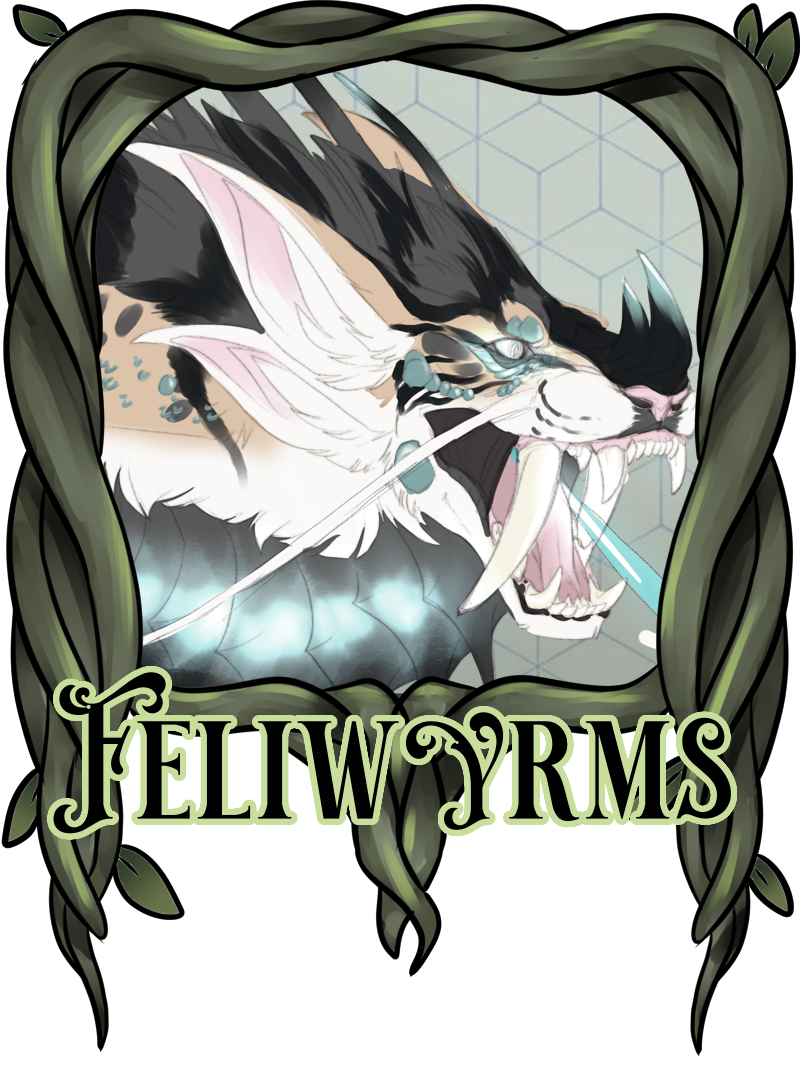 FeliwyrmsDracopanthera Amicus
FeliwyrmsDracopanthera Amicus
Companions

FELIWYRMS
Dracopanthera Amicus, Feliwyrm
An Ambush of Feliwyrm
Exotic Pet, Caregiver, Steed, Apex Predator
10 to 30 feet tall at the middle shoulder
Cub, Juvenile, Subadult, Adult
Grimsby Grove and Surrounding Areas, Parts Unknown
TO CARRY A SPARK
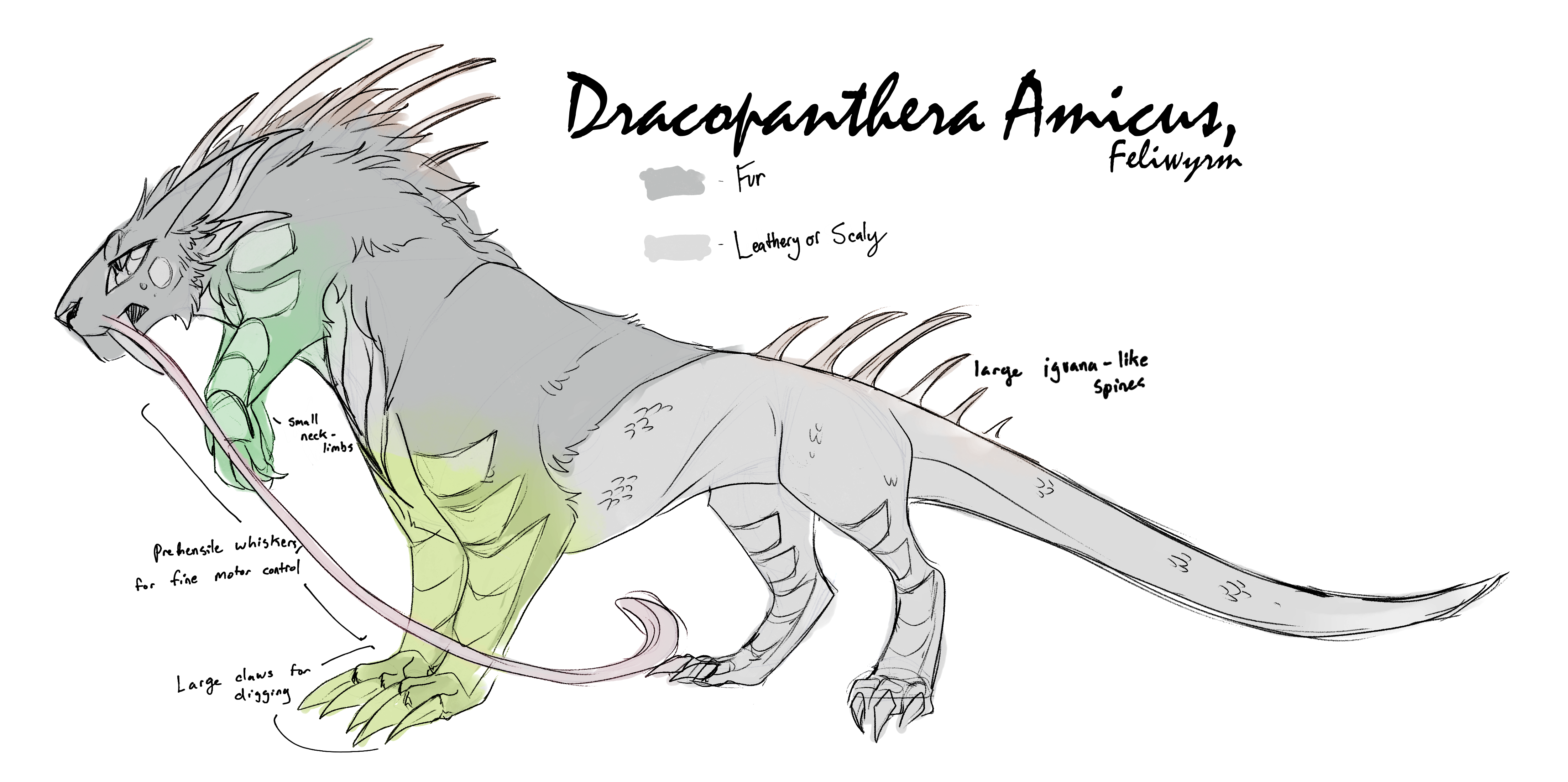
Feliwyrms are massive, leopard-like creatures that the Folk classify as Dragons. Dragons are creatures that do not engage in building societies or cultures, but carry the Spark that gives them sapience. Like other dragons, Feliwyrms can learn to communicate telepathically with Folk (by holding one of their long prehensile whisker-feelers) and can communicate physically through expression, body language, and gesture.
The longer a Feliwyrm lives, the smarter and more powerful it becomes. Feliwyrms have magical abilities like Folk do, and can breathe fire. Elder Feliwyrms are also highly intelligent and can maintain a telepathic connection with a Folk for much longer than a young one, and with much greater clarity. They can live hundreds of years, and are overall hardy and caring creatures. The magic that dwells within Feliwyrms grows, eventually, to the point where they are capable of wondrous, impossible feats of love and magic - and one of these feats is the last thing an Elder Feliwyrm will ever do.
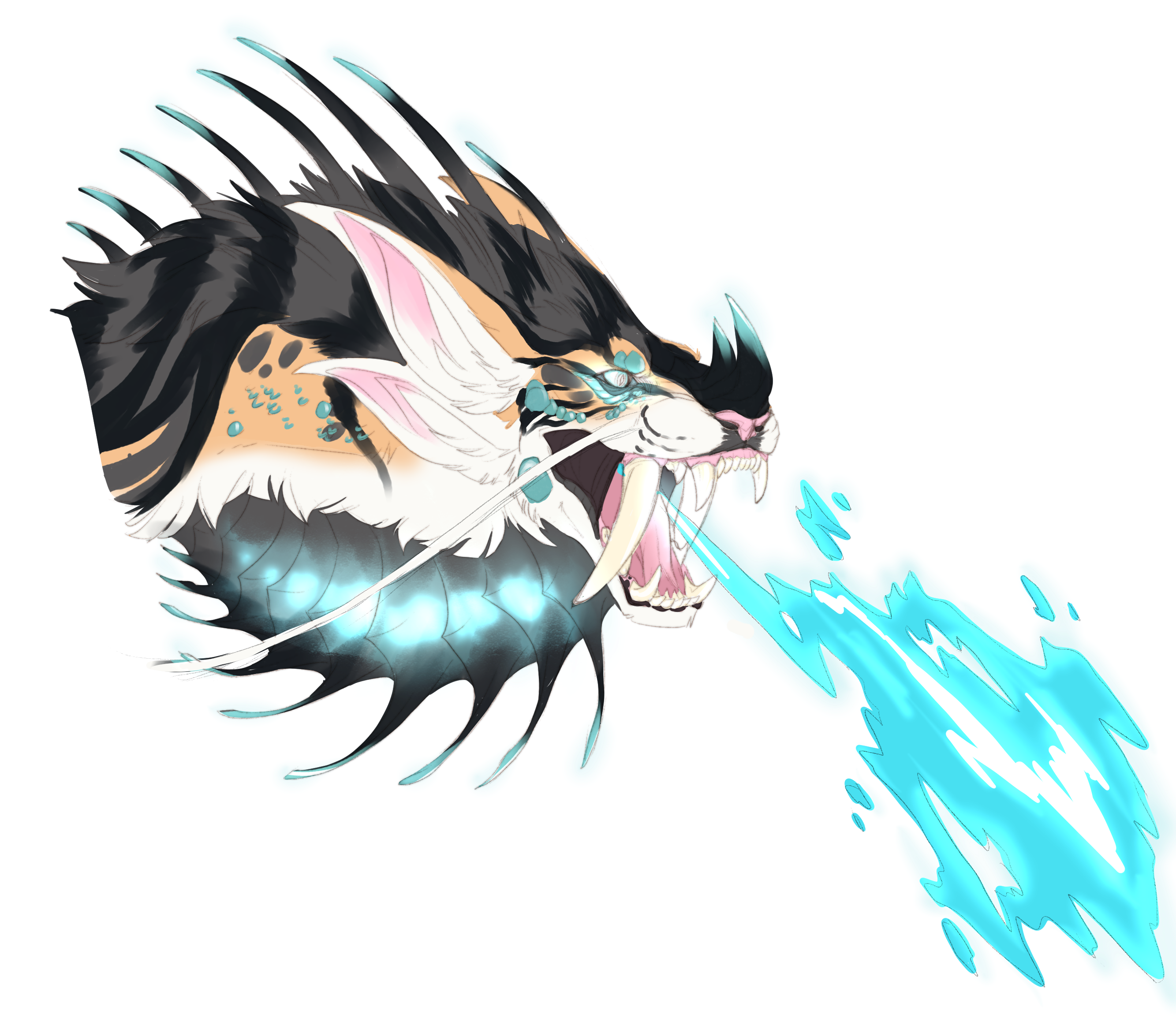
Feliwyrms, due to their large size, require a large diet. The Feliwyrm is capable of breathing fire when angered or in danger, and to facilitate this Feliwyrms consume various rocks and minerals alongside their carnivorous diet. Feliwyrm only eat meat and rocks. The mining caverns that humans left behind are the perfect places to find the large rocks that a Feliwyrm loves to eat, though the Whispering Caves can also source these minerals when Folk seek to expand them. Feliwyrm tusks are capable of cutting through steel and digging through dirt and grime to find the perfect minerals to munch. They can and will bite any threat smaller than a grown Folk in half.
Grimsby Grove has laws prohibiting bringing harm to Feliwyrms– even if the Feliwyrm is wild and seems angry. Most Feliwyrms can be reasoned with, and only in the very extreme case of a Feliwyrm attacking first and creating a life-or-death situation can a Grove folk legally retaliate. Wild Feliwyrms are endangered for one simple reason - if you threaten a Feliwyrm, be prepared for a long battle of attrition. Feliwyrms are willing to go to downright ridiculous lengths to cause even the slightest bit of annoyance or harm to those who have offended them; their level of pettiness is nearly unrivaled and unmatched compared to other creatures of the New World. Wild Feliwyrms can and will pick these battles with things larger and more dangerous than even they are.
DESTINIES INTERTWINED
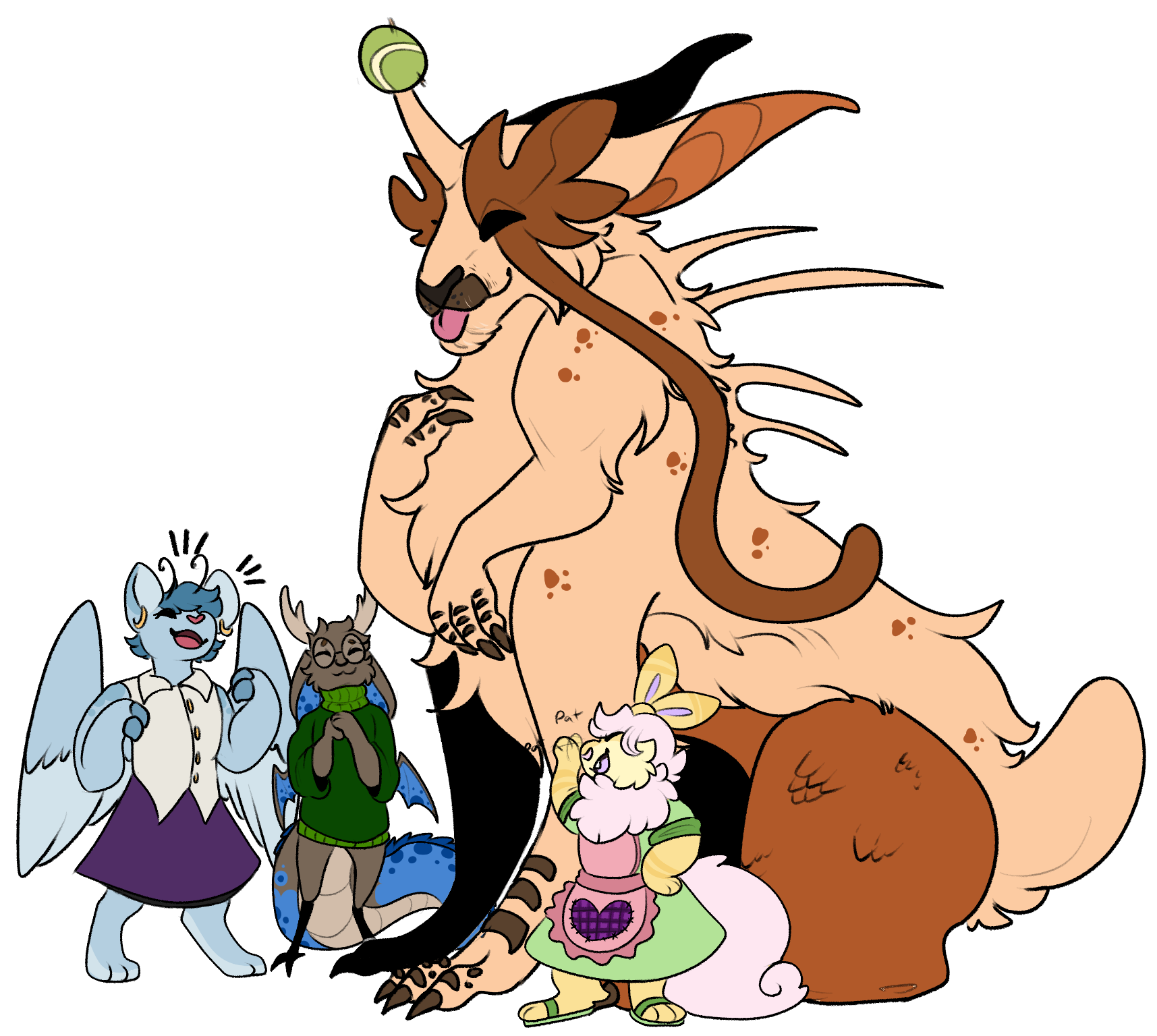
Long ago, when the Folk were smaller and the new world was younger, things were more dangerous than they were now. The Feliwyrms started bonding with ancient Folk, guarding them from danger in exchange for food and shelter; they domesticated themselves. There’s a possibility that Feliwyrms would not exist today if their ancient forebears did not team up with the Folk, and today Folk and Feliwyrm are closely intertwined. Even feral Feliwyrm have a predilection for being kind to Folk that show them respect, and there are stories of Feliwyrms inviting Adventurer’s Guild members to their lairs when they otherwise would perish.
Feliwyrms take the role of steeds and caretakers around Folk societies. They tend to lifebond with their handlers or any Folk they are in charge of caring for. A Feliwyrm’s parental instinct towards those who they consider their family are so great that Folk have a saying: "Once you befriend a Feliwyrm, they will follow you forever.” If the Feliwyrm’s handler dies, it is most common that their Feliwyrm will die shortly after of a broken heart unless it bonds with another Folk or finds a Feliwyrm mate. An age-old trick to prevent the death of a Feliwyrm is to give them an orphaned Folk kit to raise.
During the many wars which plagued Grimsby Grove’s history, disabled Feliwyrms of deceased Folk took on the jobs as Nannies and Caregivers to young orphaned Folk kits. During these times, the Den was flooded with true orphans - Folk with no remaining family - with very little staff to care for them. These disabled Feliwyrms would care for groups of 10 to 20 kits each, helping to raise them to adulthood during the hardships of war. Nicknamed “Wyrmkits” by the masses, these first wyrm-raised Folk would later create The Circle Of Moon guild and dedicate themselves to caring for non-Folk creatures and plants in the same way that Feliwyrms had done for them.
Occasionally, Feliwyrms are still given kits to care for, but in times of peace this isn’t as needed - plus, it discourages Feliwyrms from having cubs of their own. The Circle Of Moon requests that any Feliwyrm who lost its life-bonded handler to be rehomed to the Circle Of Moon’s Feliwyrm sanctuary in order for it to live the rest of their days among their own kind.
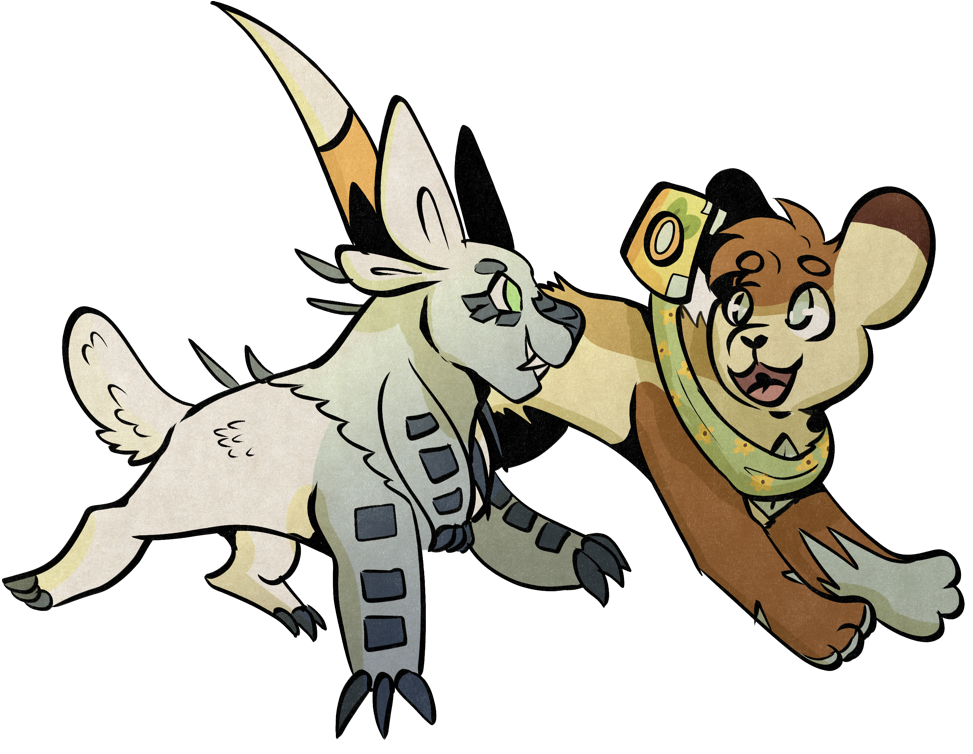
HISTORIC AND CULTURAL EXPERIENCES
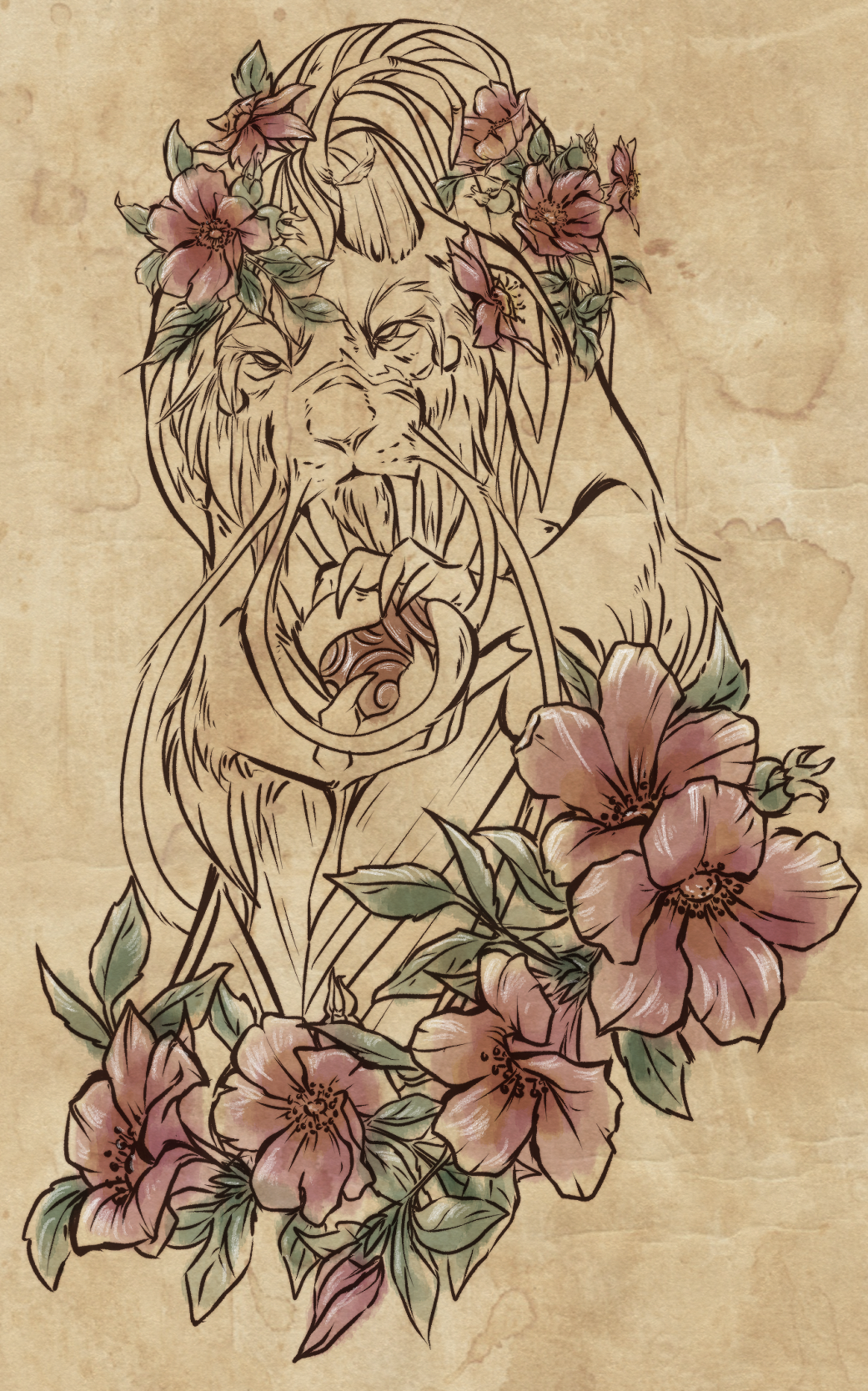
Feliwyrms are an intersex species just like Folk. They are capable of changing their reproductive organs at will to fit what position they end up in during mating. Feliwyrm, just like Folk, most commonly have their mating season during the summer. However, it’s not every year - for only 1 week in June once every 10 to 20 years, Feliwyrms will decide whether or not they will have cubs. When a Feliwyrm finds the mate of their desires, they spar to see who will become Sol and who will become Lune. These spars can last a few hours, and the loser must carry their winning mates cubs for one year before giving birth to a litter of between 2 and 12, 2 to 3 foot tall cubs. Both mates are present and care for the cubs until all cubs are adopted to new homes.
Feliwyrm cubs are born blind and deaf, but after a week their eyes and ears open for the first time. Another week after that, their coordination is advanced enough that they have the ability to walk and run around. A Feliwyrm cub masters their motor skills within 2 months. However, breeders do not separate the Lune from their cubs until they are 2 years old in order to prevent behavioral issues which may stem from being taken away too early.
A Feliwyrm becomes a full adult and sexually mature by the time they are 20 years old, and are known to always live to be over 3 centuries(300) years old. They can live much longer, depending on the individual, but will begin to show signs of advanced aging.
When a Feliwyrm dies - hopefully of old age - there is a ritual that those who were close to the Feliwyrm must perform. This ritual can have practical use for both Feliwyrm and Folk, but now it is mostly only done out of respect.
Proclaimed “The Last Journey”, the Feliwyrm’s bonded Folk coat the dying dragon’s body with seeds of any kind - flowering plants, fungi, vegetables, and in extremely rare cases they will also carry an Elder Tree Seed. The Feliwyrm would then travel with their handler to the place where the Feliwyrm wants to rest. This final journey can take hours, days or even weeks; once the Feliwyrm finds the area where they want to pass away, they use their last bit of Ether within them to translate and tell their story to their companions and facilitate the growth of the seeds they have brought. When their memory has been passed on, the plants overgrow their body and become a verdant, beautiful monument to life.
When the Feliwyrm is holding an Elder Tree seed, a rare miracle happens - their wishes for the protection of their Folk imbues the seed, and their stored ether causes it to grow rapidly. The Feliwyrm’s ancient wisdom and love manifest the framework upon which a Wyld Seal can be built, but once the Feliwyrm is gone, the new Elder Tree sapling is the Folk’s responsibility to care for and nurture. The end of a Feliwyrm is a new beginning .
TRAITS AND FEATURES
Feliwyrms can have a wide variety of traits, since proximity to the Folk's magic has allowed them a small fraction of their talent to absorb scraps of DNA from other species. However, for the most part, here are the most common traits for Feliwyrms. They are categorized into EARS, BODY, HORNS, PEETS, TAILS, and MISC.